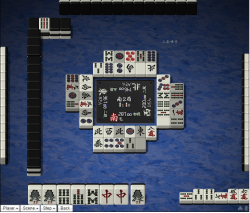Atozuke
Atozuke 「後付け」 describes a "yakuless" tenpai which gains yaku upon winning. In other words, the current state of the hand does not produce yaku while tenpai. This typically involves an open hand, but can also apply to closed hands without riichi. It is also called sakizuke 「先付け」.
When a hand is subject to atozuke, it may still win if it draws the "higher value" tile. However, it is normally unable to win off the "lesser" tile, since it would lack yaku. If the lesser tile is drawn, the hand may be subject to furiten.
Atozuke is subject to rule variations. When the atozuke rule is disabled ("atozuke nashi"), you must have a confirmed yaku before winning. More commonly, atozuke is allowed.
Examples
Note: as with any "yakuless" hand, a hand subject to atozuke may win from the lesser tile by gaining haitei, houtei, rinshan, or chankan. Closed hands can also win by mentsumo. If a hand in atozuke does not gain one of these conditional yaku, though, it cannot win by the lesser tile.
Yakuhai
Agari:
or

This hand uses a shanpon tenpai for two tiles. Winning with the haku gives a yaku through yakuhai, but winning with the 9-pin gives nothing. As this is a closed hand, it can win with mentsumo regardless of winning tile, but it can only ron off the haku (unless it gains a conditional yaku like houtei).

Agari:
or

This time, the same tiles from the above hand has an open call. At it stands, it needs the haku in order to win (or a conditional yaku like houtei).
Tanyao

Agari:
or

Tanyao can only be achieved when won with 6-sou.
Sanshoku

Agari:
or

This hand has an apparent yaku of sanshoku doukou. However, the latter wait of 3-sou would create a sequence of 1-2-3 sou, as it triggers the effect applied by the lesser valued tile. Thus, it only has a yaku when won with the 2-sou.

Agari:
or
or

Sanshoku is hinted at, however, the extended nobetan wait of 1-4-7s in the hand can ruin sanshoku if won from the 1s (it would become 11 - 234 - 567).
Counter examples
In these examples, atozuke is not used. In these cases, the hands may win on any of the waiting tiles. They each have valid yaku already embedded into the hand, regardless of their winning tiles.

Agari:
or
or

The open call on the green dragon instantly gives the hand a yaku via yakuhai.

Agari:
or

Sanshoku is already embedded in the hand.

Agari:
or
or

This hand employs honitsu.
Atozuke disabled
When the atozuke rule is disabled, the hand must have a confirmed yaku before winning. A hand that could always win under atozuke enabled may not be allowed to win in atozuke disabled.
Agari:
or

If this hand wins from 6-sou, it gains iipeikou. If it wins from 9-sou, it gains sanshoku.
- When the atozuke rule is enabled, this hand can win no matter what. Both winning tiles give a yaku, so it always has a yaku, so it can win regardless of the tile.
- When the atozuke rule is disabled, this hand cannot win. Neither iipeikou nor sanshoku are confirmed. Because this hand does not guarantee "iipeikou", "sanshoku", or any other yaku in its current state, it cannot win. (Of course, since this is a closed hand, you can just call riichi.)
To repeat, atozuke is most often enabled. So such a hand can win under most rulesets without needing riichi.
Strategy

When atozuke is enabled, players may deliberately enter the state of atozuke, depending on the starting hand. Calling tiles helps develop the hand faster, even if there's a chance you may not win later. For example, with a yakuhai pair, you may want to call early and hope someone discards the needed yakuhai later.
Risk of furiten
Open hands under atozuke run the risk of furiten. If this hand draws the 9-pin, it enters furiten. If this happens, it is possible to change waits, or win by drawing needed tile. Or you can stay tenpai until exhaustive draw to gain the tenpai payment.
External links
| |||||||||||